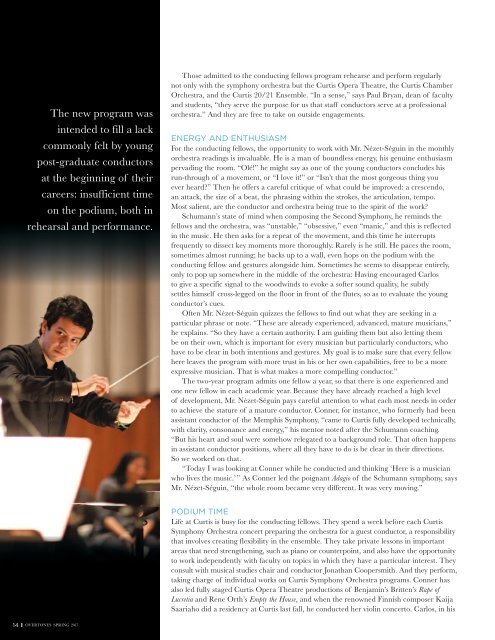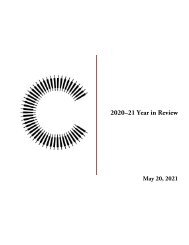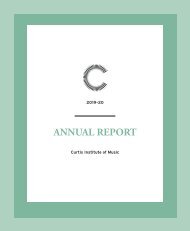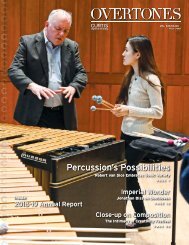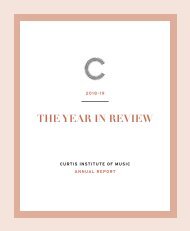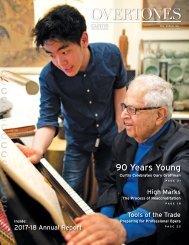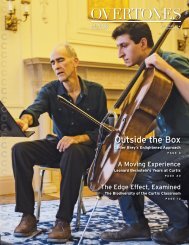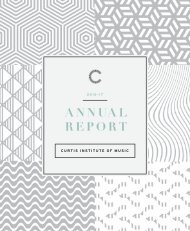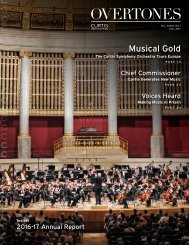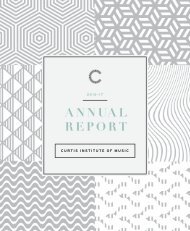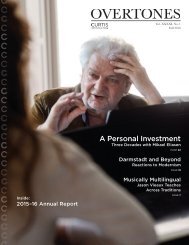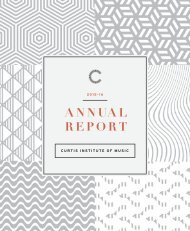Overtones: Spring 2017
Overtones is the semi-annual magazine of the Curtis Institute of Music. The latest issue highlights Curtis’s unique conducting fellows program, residencies by today’s leading composers, a compelling new way of presenting string quartets in performance, and more.
Overtones is the semi-annual magazine of the Curtis Institute of Music. The latest issue highlights Curtis’s unique conducting fellows program, residencies by today’s leading composers, a compelling new way of presenting string quartets in performance, and more.
You also want an ePaper? Increase the reach of your titles
YUMPU automatically turns print PDFs into web optimized ePapers that Google loves.
The new program was<br />
intended to fill a lack<br />
commonly felt by young<br />
post-graduate conductors<br />
at the beginning of their<br />
careers: insufficient time<br />
on the podium, both in<br />
rehearsal and performance.<br />
Those admitted to the conducting fellows program rehearse and perform regularly<br />
not only with the symphony orchestra but the Curtis Opera Theatre, the Curtis Chamber<br />
Orchestra, and the Curtis 20/21 Ensemble. “In a sense,” says Paul Bryan, dean of faculty<br />
and students, “they serve the purpose for us that staff conductors serve at a professional<br />
orchestra.” And they are free to take on outside engagements.<br />
ENERGY AND ENTHUSIASM<br />
For the conducting fellows, the opportunity to work with Mr. Nézet-Séguin in the monthly<br />
orchestra readings is invaluable. He is a man of boundless energy, his genuine enthusiasm<br />
pervading the room. “Olé!” he might say as one of the young conductors concludes his<br />
run-through of a movement, or “I love it!” or “Isn’t that the most gorgeous thing you<br />
ever heard?” Then he offers a careful critique of what could be improved: a crescendo,<br />
an attack, the size of a beat, the phrasing within the strokes, the articulation, tempo.<br />
Most salient, are the conductor and orchestra being true to the spirit of the work?<br />
Schumann’s state of mind when composing the Second Symphony, he reminds the<br />
fellows and the orchestra, was “unstable,” “obsessive,” even “manic,” and this is reflected<br />
in the music. He then asks for a repeat of the movement, and this time he interrupts<br />
frequently to dissect key moments more thoroughly. Rarely is he still. He paces the room,<br />
sometimes almost running; he backs up to a wall, even hops on the podium with the<br />
conducting fellow and gestures alongside him. Sometimes he seems to disappear entirely,<br />
only to pop up somewhere in the middle of the orchestra: Having encouraged Carlos<br />
to give a specific signal to the woodwinds to evoke a softer sound quality, he subtly<br />
settles himself cross-legged on the floor in front of the flutes, so as to evaluate the young<br />
conductor’s cues.<br />
Often Mr. Nézet-Séguin quizzes the fellows to find out what they are seeking in a<br />
particular phrase or note. “These are already experienced, advanced, mature musicians,”<br />
he explains. “So they have a certain authority. I am guiding them but also letting them<br />
be on their own, which is important for every musician but particularly conductors, who<br />
have to be clear in both intentions and gestures. My goal is to make sure that every fellow<br />
here leaves the program with more trust in his or her own capabilities, free to be a more<br />
expressive musician. That is what makes a more compelling conductor.”<br />
The two-year program admits one fellow a year, so that there is one experienced and<br />
one new fellow in each academic year. Because they have already reached a high level<br />
of development, Mr. Nézet-Séguin pays careful attention to what each most needs in order<br />
to achieve the stature of a mature conductor. Conner, for instance, who formerly had been<br />
assistant conductor of the Memphis Symphony, “came to Curtis fully developed technically,<br />
with clarity, consonance and energy,” his mentor noted after the Schumann coaching.<br />
“But his heart and soul were somehow relegated to a background role. That often happens<br />
in assistant conductor positions, where all they have to do is be clear in their directions.<br />
So we worked on that.<br />
“Today I was looking at Conner while he conducted and thinking ‘Here is a musician<br />
who lives the music.’” As Conner led the poignant Adagio of the Schumann symphony, says<br />
Mr. Nézet-Séguin, “the whole room became very different. It was very moving.”<br />
PODIUM TIME<br />
Life at Curtis is busy for the conducting fellows. They spend a week before each Curtis<br />
Symphony Orchestra concert preparing the orchestra for a guest conductor, a responsibility<br />
that involves creating flexibility in the ensemble. They take private lessons in important<br />
areas that need strengthening, such as piano or counterpoint, and also have the opportunity<br />
to work independently with faculty on topics in which they have a particular interest. They<br />
consult with musical studies chair and conductor Jonathan Coopersmith. And they perform,<br />
taking charge of individual works on Curtis Symphony Orchestra programs. Conner has<br />
also led fully staged Curtis Opera Theatre productions of Benjamin’s Britten’s Rape of<br />
Lucretia and Rene Orth’s Empty the House, and when the renowned Finnish composer Kaija<br />
Saariaho did a residency at Curtis last fall, he conducted her violin concerto. Carlos, in his<br />
14 OVERTONES SPRING <strong>2017</strong>


